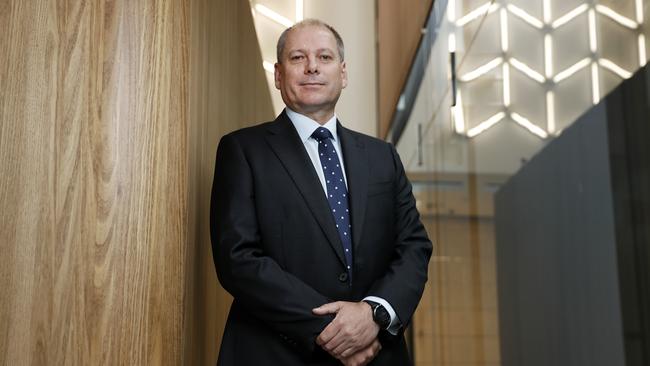Four Pillars: Peter King set to sit on the ABA throne despite woes at Westpac

While King’s ascension at the ABA doesn’t necessarily protect him from an unfortunate turn of events at Westpac, it certainly suggests he’s not going anywhere in the short term.
What’s more, if King’s day job were under serious threat, there’s precedent for the ABA skipping a chair-in-waiting.
ANZ Bank CEO Shayne Elliott took on the two-year chairmanship in 2017 due to leadership uncertainty at Commonwealth Bank, which had yet to settle on a replacement for Ian Narev.
There was some discussion at the time about breaking with convention and appointing the head of a small bank as ABA chair, but the decision was ultimately made to bypass CBA and go straight to Elliott in the usual rotation of the position between the four majors.
ABA chief executive Anna Bligh attended her last function on Tuesday night with current chair and CBA boss Matt Comyn.
Comyn’s last ABA council meeting as chair is set down for December 2. An ABA annual meeting is scheduled for the same day, at which King will be elected the new chair.
Comyn, however, will not be freeing up much time.
At the Business Council of Australia annual meeting on Wednesday, the CBA chief, along with BHP boss Mike Henry and Wesfarmers CEO Rob Scott, will join the lobby group’s board.
Comyn’s tenure as ABA chairman will be remembered for the early chaos caused by Covid-19, which led to some extraordinary interventions, such as $270bn in industry loan deferrals and massive government stimulus programs and hardship packages.
King’s big challenges are likely to be economic recovery and payments policy, including Canberra’s response to King & Wood Mallesons partner Scott Farrell’s review of the payments system.
In the meantime, leadership speculation at Westpac refuses to die down. Chair John McFarlane awarded King the full-time CEO position in April, after first appointing him acting CEO in December 2019 when the Austrac money-laundering scandal forced Brian Hartzer to fall on his sword.
The two-year term in his employment was switched to a standard 12-month notice period in October last year.
Four Pillars reported speculation about leadership instability last March, partly based on McFarlane staying true to his unconventional, hands-on style by meeting regularly for one-on-ones with senior executives.
However, a source close to Westpac said on Tuesday that McFarlane and King were still “as one” on the bank’s challenges, even though the “fix” phase of the CEO’s strategy was likely to be longer than first thought.
Mac’s green attack
The local market has witnessed a rare inflection point, with investment bank Macquarie Group’s market value motoring past one of the seemingly unassailable big four banks, ANZ, on Tuesday.
Macquarie, which was founded in December 1969 as Hill Samuel Australia, is hardly an overnight success.
However, it has displayed a consistent ability to adapt its business model to global and local mega-trends – the latest being the key role of green energy in the transition to net-zero carbon emissions by 2050.
Long-time Macquarie analyst Brian Johnson of Jefferies says the big commercial banks are, in effect, proxies for the performance of the national housing market, which inevitably slows from time to time.
In contrast, Johnson recalls attending a briefing in the 1990s to mark the company’s purchase of a stake in Hills Motorway.
“That became Macquarie’s infrastructure business today, and in 2017 they bought (green infrastructure investor) Green Investment Group from the British government,” he says.
“The difference is that Macquarie has much longer investment horizons and a longer-term remuneration structure which pays one year back (for the cash component) and seven years forward (for incentives).
“The commercial banks pay one year back and four years forward,” Johnson says
Macquarie’s potentially world-leading green capabilities in the financial sector have played a significant role in the group’s recent share-price strength.
A comprehensive review of the group last month by Morgan Stanley set a target share price of $240 – up 31 per cent from its October 11 close of $183.11.
Macquarie is already closing in on the target, with its revised market value of $77.5bn on Tuesday cruising past ANZ – which has also been spruiking its green credentials – sitting on $75.4bn.
Westpac is now within reach at $79.5bn, but National Australia Bank is a bigger hurdle at $92.4bn.
Commonwealth Bank, capitalised at $163.5bn, remains in a league of its own, despite a weak margin performance in its recent quarterly result leading to an uncharacteristic sell-off.
Macquarie is undergoing its third evolution since the 2008 global financial crisis, which it entered as a conventional investment bank.
Post-GFC, it transformed itself into a diversified and vertically integrated global asset manager by the mid-2010s, and then sharpened its green capabilities and credentials with the acquisition of Green Investment Group in 2017.
Chief executive Shemara Wikramanayake’s attendance at the COP26 climate summit in Glasgow showed just how seriously the group is taking decarbonisation of the global economy as a business opportunity.
Morgan Stanley analyst Andrew Stadnik has described Macquarie as being now a vertically integrated, private markets asset manager and developer, with potentially the world’s best green capabilities among alternative asset managers.
“We think that Macquarie will generate superior earnings growth on a medium-term view,” Stadnik said.
“Furthermore, it should command a green-premium multiple or a lower cost of capital.”
The way Morgan Stanley sees it, Macquarie is perfectly positioned for the green revolution, with operations spanning finance and development, advice, infrastructure management and operation, research and trading in emissions allowances and carbon offsets.
gluyasr@theaustralian.com.au
Twitter: @Gluyasr



Westpac chief Peter King is primed to take over the rotating chair of the Australian Banking Association, amid the latest round of leadership speculation at the troubled Sydney lender.